范老师:R音节是1个元音字母+r构成的音节(该元音字母前没有元音字母,r后面也没有跟元音字母)。 重读r音节 发长元音;弱读r音节发/ə/。如果r后面跟有元音字母或r,此r则视为普通辅音字母。
An ‘R Controlled’ vowel is one immediately followed by the letter ‘r’ and which can no longer be pronounced as a long or short vowel.R音节是1个元音字母+r构成的音节。

What are the R Controlled Vowel Sounds?
The R Controlled Vowels sounds areR音节:
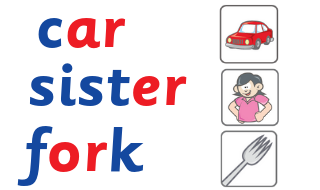
The ‘r’ following the vowel distorts the typical vowel sound, creating a new vowel sound (sometimes referred to as a ‘growl vowel’).元音后面的 “r “会扭曲典型的元音发音,产生新的元音(有时称为 “咆哮元音”)。
What are the R Controlled Vowel Representations?
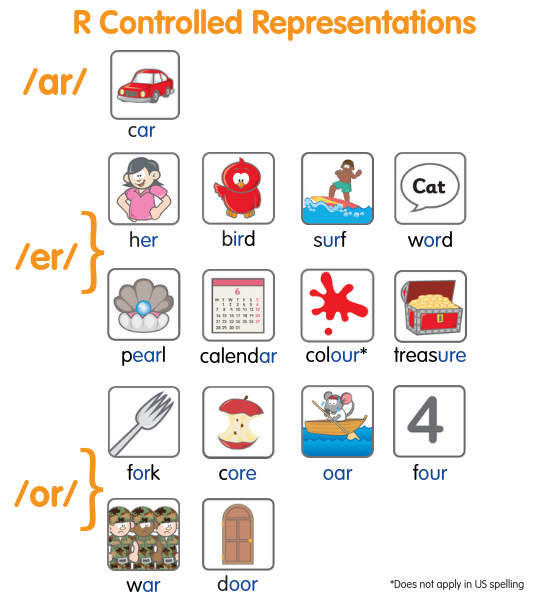
上面的的pearl, colour, treasure和door请忽略,范老师认为它们是letter teams(字母组合)。
R Controlled words make up about 10% of single syllable words. In some phonics programs, the letter ‘r’ is called ‘Bossy R’ to help students understand the strong impact this consonant has on the preceding vowels. I prefer to use the mnemonic ‘R in Charge’.R音节单词约占单音节单词的10%。在一些语音课程中,字母 “r “被称为 “Bossy R霸道的R”,以帮助学生理解这个辅音对前面元音的强烈影响。我更喜欢使用口诀’R in Charge(R做主)’。
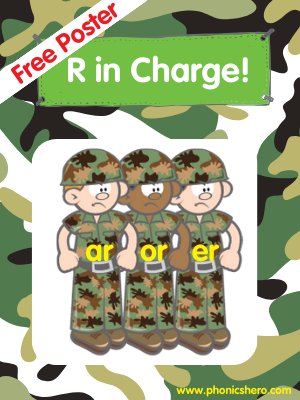
How to Teach the R Controlled Vowels
Start with ‘/a:/’
In systematic phonics instruction, you move from simple to complex and most common representations to less common. Because /ar/ is the most commonly used R Controlled Vowel sound and has only one representation, we use this to introduce what happens when ‘r’ is in charge.在系统的语音教学中,你会从简单到复杂,从最常见的表征到不常见的表征。因为/ar/是最常用的r控元音(R音节)。只有ar发/a:/。
Use a ‘Compare and Contrast’ Strategy.
Have your students read CVC words containing short ‘a’, for example: ‘can’, ‘cat’, ‘cab’, and ‘cap’. Tell the students that the consonant ‘r’ changes the sound of the vowel immediately before it and read the word ‘car’ for them. Repeat the process with other CVC words, asking the students to read the word with ‘ar’ (there’s a worksheet for this in our ‘ar’ worksheet bundle below).
The Sound Substitution Strategy
Have the students read ‘cat’ then replace the ‘a’ with ‘ar’ and read ‘cart’ (there’s also a worksheet for this in our bundle!) Have them read ‘had’ then replace the ‘a’ with ‘ar’ and read ‘hard’. Repeat the process until the students understand this concept.
Teaching Tips
An R Controlled Syllable is one of 6 types of syllables. Have the students read two-syllable words with ‘ar’ in the first syllable only. e.g. ‘ar-my’, ‘par-ty’, ‘car-go’. DO NOT give the students words with ‘ar’ in the second syllable at this stage (I’ll explain why a little later).
When counting the number of sounds in a word, ‘ar’ counts as just one sound, /ar/. You can help struggling students to remember this by using sound buttons for sound counting (as seen in the Letters and Sounds program). For example:

Notice how the ‘ar’ is underlined for the reader to indicate that it is a digraph – two letters are representing one sound.
Once the students can read ‘ar’ words, you can move on to the spelling of these words. A common spelling error of beginning spellers is writing the letter ‘r’ by itself for /ar/. This is a confusion of letter name and sound. Explicitly teach them that the letter name for ‘r’ is pronounced as /ar/ but this is not the sound it represents. The sound that the letter ‘r’ represents is similar to the sound of a puppy barking, /r/, as in ‘red’ and ‘run’. Remind the students of the mnemonic ‘R in charge’ – the letter ‘r’ must be in charge of a vowel when representing /ar/, so when writing /ar/ the vowel ‘a’ must precede the ‘r’.
R Controlled Vowels Worksheet Activities
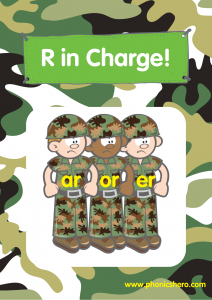
I’ve worked alongside the Phonics Hero team to put together Worksheet Packs supporting the following R Controlled Vowels:
- /ar/ – includes the ‘ar’ spelling choice.
- /er/ – includes: ‘er’, ‘ir’, ‘ur’, ‘or’ and ‘ear’ spelling choices.
- /or/ – includes: ‘or’ and ‘ore’ spelling choices.
Activities provided in the pack, or those you can make yourself, include:
- Compare and Contrast – find the words in which you see ‘r’ following ‘a’.
- Sound Substitution – rewrite words with a controlling ‘r’ after the vowel.
- Rhyming – e.g. car/bar. Students listen for rhyming words or draw lines between rhyming words drawn from two columns. Students can also try to create rhyming couplets e.g. “I know that I could not go far unless I had a bike or car”.
- Oral Phoneme Manipulation – substitution, addition, deletion e.g. bar-barn-bark.
- Word Sorts – for example, words with/without R Controlled Vowels, words with a specific R Controlled Vowel representation).
- Picture – Word Match
- Word Completion – with one or more sounds missing.
- Sound Button Spelling – writing of words with teacher-provided dots indicating number of sounds or dashes indicating number of graphemes (copying first, then from memory).
- Independent Spelling words from pictures
- Word Searches
- Picture – Sentence Match
- Scrambled Sentences – provide the words that make up a sentence for the students to arrange correctly. This makes them really look at the words!
Other R Controlled Vowels Activities:
- (Prior to writing letters) oral blending and segmenting of words e.g. p-ar-k.
- Word construction using magnetic letters, letter tiles, wikki stix etc. You may want to use a phoneme frame.
- Writing words phoneme by phoneme in alternating colours.
- Boggle: provide the students with a number of vowels, an ‘r’ and some other consonants in a grid. The challenge is to make as many real words as possible – 3 letter words win 3 points, 4-letter words 4 points etc.
- Visual tracking: looking for the focus R Controlled Vowel/s in a line of graphemes.
- Phoneme spotter reading: the student highlights the focus R Controlled Vowel/s in tex.t
- Reading and writing captions words containing R Controlled Vowels.
- Sentence reading and writing (copying, dictation, innovation).
- Paragraph writing e.g. “Shirley is a little girl. She has a purple skirt and shirt. She likes to twirl and whirl. Her skirt is a blur!”
- Games such as Bingo, Snap, Concentration, Snakes and Ladders, 4-In-A-Row, Hangman that make students focus on the vowel-r combinations.
- Any form of board track game in which the student moves his counter along a track and reads or spells the R Controlled Vowel word on which his throw lands him.
- Use lots of multi-sensory games and technology-based games to develop automaticity. In the Phonics Hero Letters and Sounds progression, you will find ‘ar’ and ‘or’ on level 6A and ‘er’ on level 6C. Access free resources with a Teacher Account here.
Introducing /ɜː//ə:/
The second most frequently heard R Controlled Vowel sound is /ə:/. It has quite a few representations. These representations and their relative frequency can be remembered with the sentence。er,ir (yr), ur 都发/ə:/。

Knowing the frequency of each representation can help the student make an educated guess regarding the correct choice of representation, as there are no rules guiding choice in one-syllable words. I suggest that you introduce ‘er’, ‘ur’, and ‘ir’ together initially but make the ‘er’ representation your first focus so that the students can build confidence using the most common representation. There are some fun Internet videos on the three frequent /ir/ representations, for example:
Point out the frequency of ‘er’ as a representation of /er/ to your students. Use the activities listed above, under Activities, to teach ‘er’ in one-syllable words. When ‘er’ is used in words of more than one syllable, this vowel-r combination still represents /er/ so you can move on to these words with confidence. The only exception is when the schwa sound is substituted in some dialects. I will explain this in detail a little later.
The ‘er’ spelling is used for /er/ sometimes as a morpheme (a meaningful unit). It is used at the end of a comparative adjective (like ‘faster’). It is used at the end of some nouns to indicate an occupation (like ‘farmer’). Making links to meaning will help students to recall the correct representation.
The ‘ur’ representation
Reading the ‘ur’ representation of /er/, or any other R Controlled Vowel representation, is not hard once the student knows about R Controlled Vowels. Spelling using the correct representation is much harder so will require greater frequency, intensity, and duration of instruction. There are no rules indicating when you should use ‘er’ and when you should use ‘ur’ to spell /er/ in a syllable. Lots of activities exposing the student to the two representations are needed to develop visual and motor memory. In addition, I use mnemonics to help students learn some ‘ur’ words. Some are visual mnemonics. For example, you can make a u-turn. The words ‘curl’ and ‘curve’ contain the letter ‘u’ which looks like a curl or curve.

Some mnemonics are sentences based on the words ‘you’ and ‘are’ in text message format, e.g:

The ‘ir’ representation
I haven’t found or created any really clever mnemonics for spelling ‘ir’ words (if you’ve got one, I’d love to hear it in the comments below). I sometimes remind students of the spelling in sentences such as:
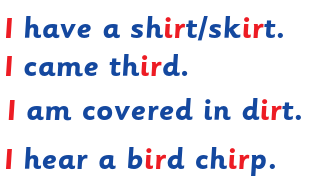
The existence of homophones (same sounds, different meaning and spelling) can make the spelling of a couple of ‘ir’ words more challenging. One example of homophones is this pair:

I use a combination of mnemonics and pictures to help a student differentiate between the two. A Christmas tree is often a fir tree. You can think of the ‘i’ as a strong trunk with a star on top. You can think of a furry animal you love curled up beside you and say ‘U r furry!’ The student draws the picture underneath the word. A student may come up with a better memory jogger than you (or I) can. The important thing is that the picture is meaningful and memorable to them.
Once you have taught the three most common representations of /er/, have your students play games that encourage thinking about these spellings. Go Fish and Happy Families are great card games for increasing awareness of the representations of /er/.
Tricky ‘or’ – /er/ and /or/
The letters ‘or’ can be used to represent both /er/ and /or/, for example:

Students are used to seeing these letters as the word ‘or’ so I think it is easier for them to learn the connection with /or/ than the connection with /er/. Based on the philosophy that I want to make learning as easy as possible for students, I would teach ‘or’ as /or/ first, using the activities already provided. The ‘or’ spelling of /er/ is predominantly used after a ‘w’ in a one-syllable word. Students have two rules to learn in connection with the ‘wor’ spelling:
- When ‘w’ comes before ‘o’ in a syllable, it changes the vowel sound to short /u/ as in ‘wonder’.
- The ‘r’ in words like ‘word’, ‘worm’, and ‘worth’ changes that short/u/ sound to /er/. Watch for student confusion with the irregular word ‘were’.
I sometimes refer to the letter ‘w’ as the Wizard W, as it can change the usual representation of /æ/ to /ɔ/ and the usual representation of /a:/ to /ɔ:/ as in我有时把字母’w’称为魔法师W,因为它可以把通常的/æ/的表示方式变成/ɔ/,把通常的/a:/的表示方式变成/ɔ:/,把通常的/ɔ:/的表示方式变成/ə:/就像
what, want, watch, swan, swap, want, wand, wasp, wash,这些a都跟在/w/后面,跟在/kw/后的也适用于此规则,如:quarter, quality, quad, squad, squat, squash例外swam, wham
war, towards, swarm, ward, warp, reward, warn, warning, wardrobe, dwarf
word, work, worm, worth, worthless, worse, worst, worthy

It makes sense to teach ‘wor’ and ‘war’ in the same lesson as both are under the control of both ‘r’ and ‘w’.
The ‘or’ combination can also be used to represent /er/ in the second or third syllable of a word, as in ‘doc-tor’ or ‘dec-or-ate’.
Teaching Tips:
You may ask a student to use a ‘spelling voice’ when spelling such words, pronouncing the ‘or’ as /or/. The ‘or’ can be a morpheme, referring to an occupation such as ‘surveyor’, ‘inventor’ and ‘editor’. (Someone once told me that the amount of money one could make was indicated by whether your occupation ended in ‘er’ or ‘or’. It may work for ‘teacher’ and ‘cleaner’ but I don’t think it works for ‘lawyer’ or ‘boxer’, amongst others).
N.B: ‘ar’, ‘er’, ‘ur’ and ‘or’ are covered in Phase 3 of Letters and Sounds, while ‘ir’ is introduced in Phase 5.
‘ar’ as /er/
All of the vowels can be combined with ‘r’ to represent /er/. The ‘ar’ combination is used in words such as ‘dollar’, ‘vulgar’ and ‘polar’. Multi-syllable words ending in ‘ar’ as /er/ are often adjectives. The use of meaning can help students to correctly spell this representation.
When /ir/ is replaced by a schwa
In Middle English (spoken 1150-1500) the letter ‘r’ always represented a consonant sound. An ‘r’ following a vowel would have been pronounced in the same way as an initial ‘r’. Through the years, it came to also represent a vowel change before the ‘r’ heard in some dialects. The degree to which you can hear the impact of the ‘r’ in each of the R Controlled Vowel sounds depends on the accent of the speaker. For example, the ‘r’ is likely to be more pronounced when the speaker is of Scottish or French origin. In contrast, in some dialects of English (for example, the Australian dialect), the /er/ represented by ‘er’, ‘ar’, or ‘or’ is not more pronounced but rather replaced by a schwa sound (Learn more about the schwa in my blog here), usually in unaccented syllables. Try saying:
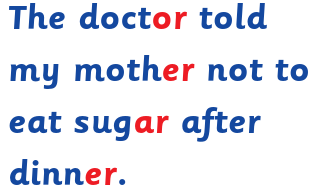
For the red representations, do you hear the /ir/ pronounced? Or do you hear the sound /uh/ (like the sound someone makes when trying to think of a word)? The schwa is the most common vowel sound. It is because of schwa substitution that it is so important for students to get used to reading the words with unaccented syllables containing an R Controlled Vowels before they are asked to spell them. When they do spell them, you may ask them to use their ‘spelling voice’ and exaggerate the /ir/.
When R is NOT in charge当R不在做主时
- 当r后面跟了元音字母时 e.g. ‘ver-y’, ‘chari-ty’, ‘spirit’
- When a double ‘r’ follows a vowel, the /r/ sound goes off with the next syllable, leaving the short vowel sound unchanged, as in: cher-ry or car-rot. It is important that students be explicitly taught that the doubling rule trumps the control of the ‘r’.当双 “r “跟在一个元音后面时,/r/音会随着下一个音节而消失,而短元音不变,如:cher-ry或car-rot。重要的是,要明确告诉学生,双倍规则胜过对’r’的控制。